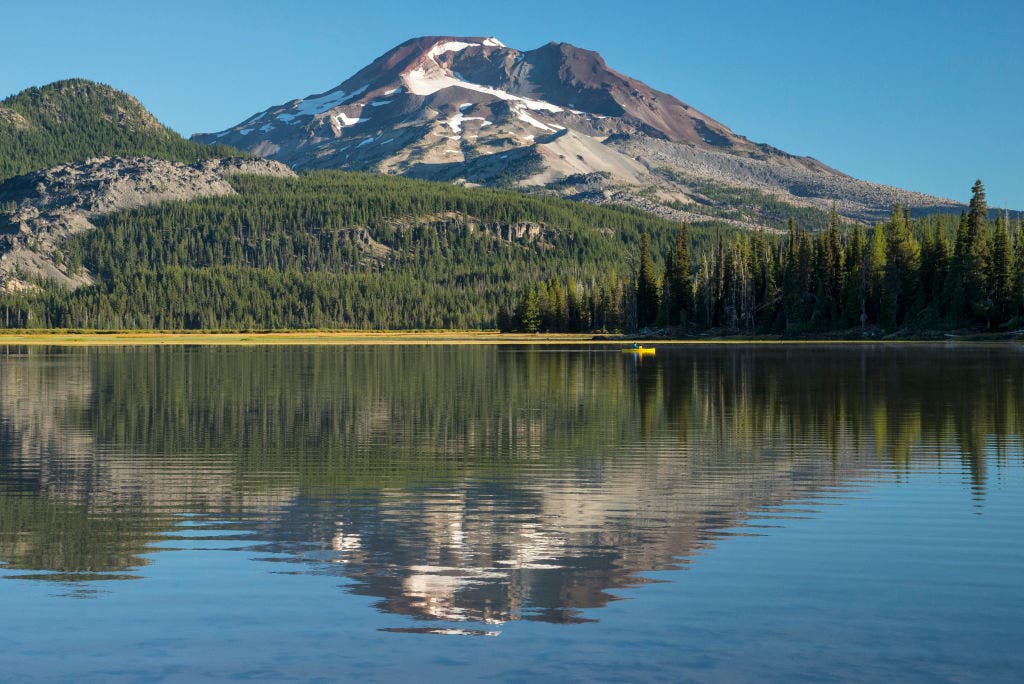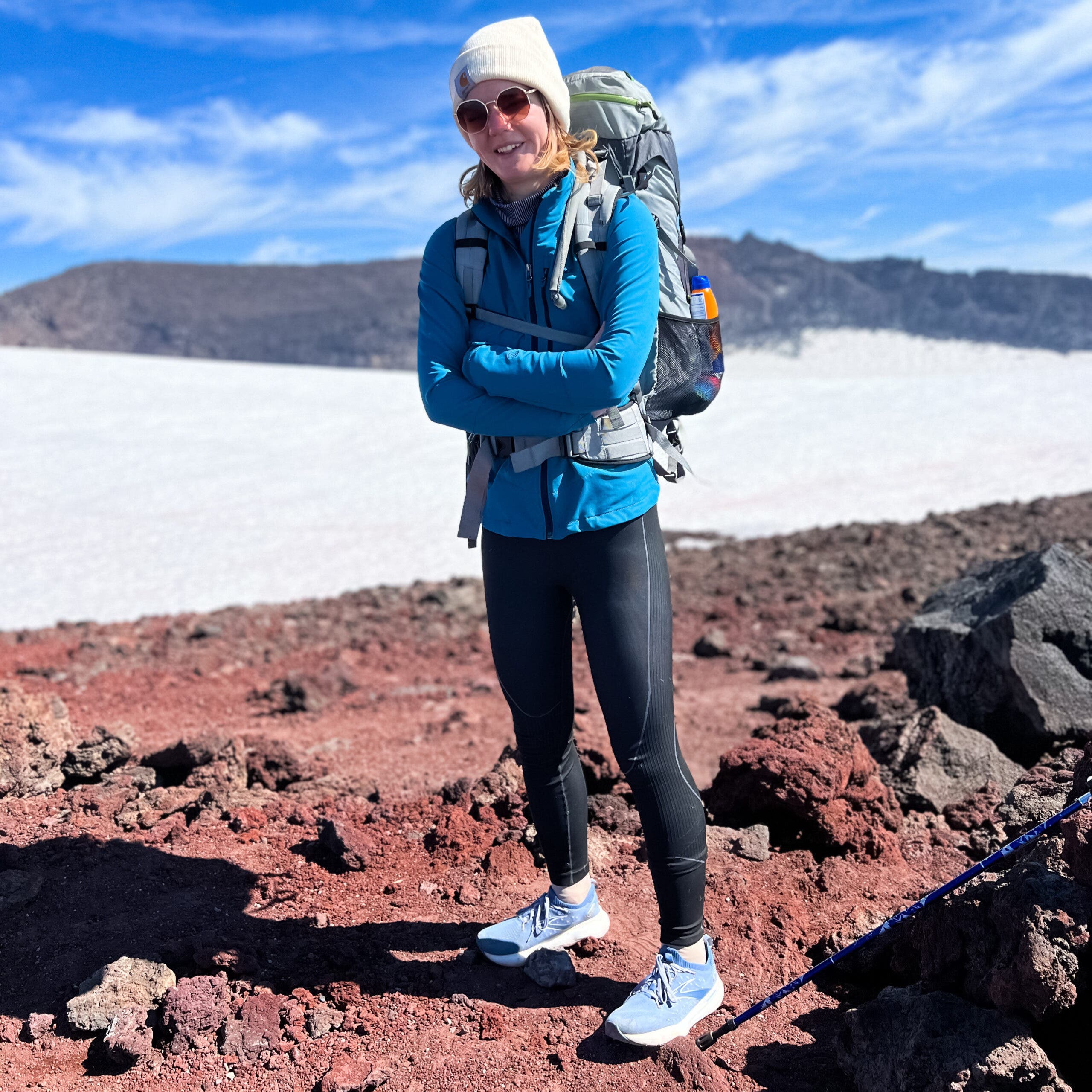What It’s Like to Climb a Mountain in Stilettos and Formalwear

The author and her partner before their formalwear hike (Photo: Junnelle Hogen)
The air was bad. Wildfire smoke from the Flat Creek fire had settled across Central Oregon, tinting the Cascades in an eerie dusk-light even though it was only late afternoon. My boyfriend, RJ, and I had already planned an adventure: 5,000 feet of vertical gain up the South Sister Trail near Bend, followed by a night of camping at 10,000 feet elevation near the summit of the volcano. We packed our gear.
Then we packed our suits, ties, and fancy shoes.
I wrapped my toes in climbing tape and slid them into a pair of stilettos. Nylons, silk shorts, and a dappled gray blazer completed my look. RJ wore a full suit jacket, tie, and tailored pants. No, this wasn’t a dare. We weren’t filming a prank video. We were just wondering—since everything around us felt a little off— what if we shifted our outdoor experience, too? What would happen then?
It turns out, a lot.
At the trailhead, a ranger clocked us with an expression that sat somewhere between curiosity and concern.
“You guys going to a wedding up there?” she asked.
I shrugged and answered, “These views serve. Maybe we have to.”
She laughed. But I could feel it—just under the banter, a question: Are you actually going to climb the trail dressed like that?
We were. From the moment we stepped into the tree line, the clothing stopped being a bit and started changing how the hike felt.
How Formalwear Reframed the Trail
I’ve hiked the trail to 10,358-foot-tall South Sister plenty of times. It has classic high-desert alpine ingredients: steep switchbacks through pine and lichen, a push through alpine tundra, and a final grind to a cratered summit. I knew the terrain. But this time, everything felt unfamiliar.
When wearing traditional hiking clothes, I melt into the landscape. I hunch, I focus, I go quiet. The goal is movement, efficiency.
But in a blazer and heels? I didn’t vanish. I stood out. Every footfall felt like a decision. Every hiker who passed us did a double-take. People stared. Pointed. Engaged. And with that attention came a shift. We weren’t just hiking; we were performing.
At first, I felt a little ridiculous, but not in a bad way. More like I’d walked into a role I didn’t know I wanted to play. The trail had become a stage, and the hike a kind of moving monologue.

My feet hurt immediately. The stilettos made every step deliberate, and by the third mile, I was counting breaths to distract from the sting. But weirdly, I wasn’t annoyed. The pain felt like something I’d chosen to experience on purpose. Which, of course, I had.
I thought about the discomfort I’ve pushed through while running ultramarathons—raw toes, bruised legs, heatstroke, deep rain chill—and realized this wasn’t so different. Just less expected.
There was something freeing about opting into impracticality. Hiking usually strips things down: gear, food, thought. But our unorthodox attire added flair, friction, absurdity, and it lightened the emotional load. I wasn’t trudging. I was dancing. Or trying to.
RJ and I started riffing as we climbed, pretending we were late to some mountaintop charity ball. I hummed songs. He cracked absurd jokes. We were laughing a lot more than we usually do on steep terrain.
Who Wears What Where?
The outfit made me hyper-aware of my body, but also of the bodies we expect to see on trail. When you’re dressed like you belong in a hotel lobby, you don’t blend in among the ultralight packs.
People didn’t seem offended by our goofy clothes. Mostly, they seemed delighted, or confused, or a little of both. But there’s an undercurrent, always, when you break the uniform code of the outdoors. There’s a version of “legitimacy” hikers are expected to carry. Our suits didn’t signal expertise. They signaled what? Vanity? Humor? Defiance?
For me, it felt like none of those things. It felt like the formalwear gave me permission to inhabit the trail differently. To be less hardened. More playful. A little performative, sure. But also more me.
I started thinking about where the outfit had been before. The tights, worn to many networking events and professional functions. The blazer I wore at my first career job. The heels were part of my professional attire when I had worked in Washington D.C. in a pivotal personal-growth era.
All those old versions of me were stitched into these garments. And now I was dragging them through dirt, lava rock, and smoke. There was something cathartic in that.
We always say that the outdoors helps us shed baggage. But what happens when you bring it with you, literally, it turns out, some of it gets rewired.
Above the alpine basin, the South Sister trail tips sharply into volcanic scree—1,300 feet of loose, shifting ground. The stilettos gave up. I slid, stumbled, and took one too many bad steps.
I sat down and swapped into trail runners. Not for relief, but for safety.
The moment they were on, I felt stronger. But something shifted. The formality was over. I was a hiker again. Efficient. Grounded. Slightly bummed.
I left the blazer on.
No Party at the Summit
We reach the top just after midnight. Stars overhead. A Glacier to our left. Smoke pooled in the valleys like a held breath. We didn’t say much. Instead, we just pitched the tent, climbed into bags, and let our bodies shake the cold out.
I thought I’d be tired. Or sore. Or annoyed at myself for the whole stunt.
But I wasn’t. I felt clear. Worn out in the best way.
At sunrise, I unzipped the tent and stepped barefoot onto basalt. The world below us was cloud and fire haze, a thick, still ocean of silver and orange. I couldn’t see the trail, trees, or rangers. There was only the sky above, smoke below, and silence.
There’s something about effort wrapped in absurdity that makes you feel more present. I’d carried useless shoes to the top of a mountain. My feet were, still, far too tight from the climbing tape. My muscles were shot. My tights were dusty toast.
But somehow, it made the entire experience sharper. Truer. Not in spite of the outfit—but because of it.
So Why Hike in a Suit?
Why suits? Why in smoke? Why in heels?
The still, quiet part of my brain knew the answer: Because sometimes the best way to remember who you are is to step fully outside the expected. Because we’re not always at our most alive in performance gear. Because joy can look ridiculous.
And maybe, because not every summit has to be earned with grit alone. Some of them can be reached with a little style, a little satire, and a willingness to look absolutely unhinged in front of strangers.
As we embarked down the same scree—it was flanked in light—the journey was much easier in my Brooks running shoes. My feet, cramped and stiff, began to pulse. I wanted to get down and sit down.
I sped up my pace, but RJ kept the same rhythm.
“Hey, go for it,” he encouraged. “Get back to the trailhead. I’ll meet you there.”
So I rushed down switchbacks, so many switchbacks. And I counted each clearing.
After a few false hopes, I heard cars and emerged from the trailhead, overeager, and popped out at an upper parking site, too soon. I followed it down the lower lot, where I found the car. I softly unclamped my waist buckles, letting myself settle into stillness.
Half an hour later, RJ showed up, grinning, relieved, exhausted. We stretched our tightened muscles.
“Junnelle, I haven’t done something like this since Mount Fuji. Just, wow. Would you go again?” he asked me.
Absolutely.
Because isn’t there something marvelous in the new lighting, the unprovoked act, the trial and the summit, that reminds us how precious it is to be alive and fully living, reminds us that these choices are ours to make, these experiences ours to gather? Isn’t there something in it that reminds us how ridiculously absurd, and wonderful it is, to create that?

Junnelle Hogen is a freelance journalist covering the outdoors, social issues and personal narratives. She currently focuses on medical policy and is set to publish her first book, titled Begin Again, about recovery from a 65-foot climbing fall.Â